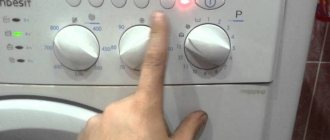The washing machine has long become a familiar type of household appliance, which is used in virtually every Russian family. For some housewives it can be used daily. As long as the operating requirements are met, there is nothing to worry about. However, if you periodically violate these requirements, then, most likely, the machine will begin to produce errors during the execution of the program, that is, malfunctions will begin to appear in its operation. Let's try to figure out what happens if you overload the washing machine in this article.
Causes of overload and imbalance
The manufacturer clearly states in the instructions the amount of laundry in kilograms for loading on a specific washing program. But few people think that regularly exceeding the permissible weight limit provokes overload in an automatic machine.
Some things: jackets, bedspreads, blankets may meet the maximum weight stated in the washing machine instructions, but be very bulky and, when loaded, cannot move freely in a drum filled with water. If laundry piles unevenly in one part of the drum, it will inevitably lead to an imbalance.
All these factors cause harm to household appliances, which inevitably results in the appearance of errors in the program, and then the failure of the machine itself. Sometimes repairs are so expensive that it is much easier to buy new equipment. But it’s still better to avoid overload and imbalance, causing breakdowns.
Calculation of laundry weight before washing
To be sure that the machine is not overloaded, you need to know the weight of things in advance. Modern washing machines have an “auto-weighing” function. With this function, the machine display will indicate the weight of the items loaded into the drum.
If there is no such function in the car, then it is worth remembering or having a reminder with you about how much the main things weigh:
- pillowcase - 200 g;
- sheet - 500 g;
- duvet cover - 700 g;
- bath towel - 500 g;
- tablecloth - 500 gr;
- socks and underwear - from 50 to 200 g;
- blouses and shirts - from 100 to 300 g;
- T-shirt - 150 g;
- jeans - 300–800 g;
- trousers - 200–700 g;
- dress - 300 gr;
- sweater - 150–600 g;
- adult jacket - 900–1700 g;
- children's jacket - 400–800 g;
- robe - 300–500 g;
- children's things - 30–200 gr.
The maximum weight of loaded items and the table below apply to dry items.
List of main breakdowns caused by exceeding the norm of laundry in the washing machine
There are a number of malfunctions that appear as a result of regularly exceeding the permissible amount of laundry in an automatic machine, or when an imbalance occurs.
- The machine's centrifuge has difficulty rotating the drum, which is overloaded with clothes, which deteriorates the quality of the wash and affects the duration of the set program. With constant overload, the rotation intervals slow down and the washing machine may stop completely in the middle of the wash cycle.
- The imbalance causes vibration during the spin phase, the machine begins to move from the established place, making loud, unpleasant sounds. Parts inside the equipment may suffer from sudden jumps. Some washing machines are equipped with a sensor for monitoring the occurrence of an imbalance, and if it occurs, further washing processes are turned off.
- Constant overload will lead to failure in the bearing assembly due to destruction of the bearings.
- The tightness of the sealing collar on the drum weakens over time, or the rubber completely breaks, and water begins to leak from the hatch.
- Systematically exceeding the permissible amount of clothing in the drum leads to the failure of dampers - shock absorbers, which act as a reduction in the likelihood of an imbalance. When designing, the manufacturer places the appropriate load on them, depending on the permissible loading volume of the machine. A non-functioning damper causes the imbalance sensor to trigger, and the operation of the washing machine stops during the spin phase.
- The drive belt may not be able to withstand the regular additional load and may break.
- The motor of the equipment, which performs its functions under constant overload, overheats and may eventually burn out.
Exceeding the weight of the loaded laundry
Few housewives know the exact weight of things and measure them before washing. And because of the desire to get through the laundry as quickly as possible, some people load more than is allowed. As a result, a number of unpleasant processes occur with the washing machine:
- due to overload, vibration during spin increases;
- the motor overheats because it requires more power than provided by the manufacturer;
- there is a risk that the laundry does not wash or is not rinsed completely;
- water and electricity consumption increases.
Overheating of the motor in most cases leads to a short circuit. And this is a fire risk. Therefore, manufacturers do not recommend using more weight than indicated in the instructions.
Another important point when loading laundry is that each program has its own permissible maximum load. And usually only the cotton washing mode has a full load. In other cases, it is recommended to pledge a third or half of it.
For delicate wash cycles and woolen items, the manufacturer usually indicates a volume of one third of the maximum. For express washes, it is permissible to load at half the volume. This is due to the fact that the machine is not capable of efficiently washing a large volume in 15–30 minutes.
Ways to avoid the consequences of overload and imbalance
There are several simple rules, the observance of which will help not to overload household appliances and prevent the occurrence of an imbalance, and, as a result, serious damage to the washing machine.
- It should be remembered that the maximum weight is calculated based on the number of kilograms of things that are in a wet state. Not all machines are equipped with a sensor for determining the weight of loaded laundry. Therefore, either empirically - by weighing a certain type of item once, or by obtaining information from the Internet, you need to find out the approximate weight of, for example, bed linen or other bulky clothing. The machine also does not like to wash too few items. Therefore, choose the optimal load volume of laundry, according to the instructions for household appliances.
- When loading, you must ensure that there is enough free space in the drum to ensure the free movement of things inside it during the washing process. This must be done before starting the program and if the clothes have difficulty moving during rotation, it is better to remove half of the laundry, or even refuse to wash clothes that are too bulky in the washing machine.
- By ensuring a flat surface (on concrete floor or tile) before installing the appliance, you can avoid the appearance of unbalanced washing. It would be a good idea to install the legs of the washing machine on special anti-vibration stands if the floor has a slope.
- An important task of the housewife before washing is to sort the laundry by type of fabric. Do not wash different types of fabric at the same time on a program intended only for cotton, synthetics or wool.
Strictly follow the manufacturer’s recommendations, which he prescribes in the operating instructions for the washing machine, this will protect you from malfunctions and unnecessary expenses.
If you still have a problem and the machine freezes during the program, you need to remove the bottom panel of the equipment and, opening the valve, drain the water from the drum. Then simply remove a few extra items that create an overload, or distribute unevenly bunched laundry around the drum and start the program again.
How to determine overload in a washing machine
To do this, you need to follow the one-hand rule - you need to place your hand in the drum so that it is located at the top and between things, after which it is determined how much free space remains. If the hand climbs in without difficulty, this means that the loading was completed correctly. If it is difficult for your hand to fit into the drum, it means that there are more things loaded than the allotted amount and excess clothing, you just need to remove it.
The washing machine can also be reloaded if a certain weight limit is not met; most often, an automatic washing machine places an average of 3-3.5 kg of laundry items. Therefore, before using it, be sure to read the instructions for use to be completely sure.
How to determine the weight of laundry for a washing machine yourself
To properly load the machine drum, you need to know a lot of dry things. For example, bedding labels indicate how much a set weighs. Once you remember this number, you can assemble the laundry by eye. Of course, not every item has this information, and not all housewives save labels. Therefore, it is better to determine the exact mass using household scales, if available. Place all dirty items in a bulk bag or sack and weigh them before putting them in the car.
You can also use floor scales. Determine the initial weight of the person, and then together with the underwear. The resulting difference will be the initial weight of the upcoming wash. Or weigh the basket without laundry, and then with laundry, to also calculate the difference. It is not necessary to recognize this every time; after several weighings, it is easy to remember each item or composition to put into the machine. Just combine similar things, and the norm will be met. If there are difficulties with this, you can write down the data obtained after weighing and create your own table for use in the future.
Weighing laundry before washing (photo source: Yandex.Pictures)
If you didn’t plan to buy scales for your home, there are online calculators on the Internet. They help to approximately calculate the weight to load into the machine. The hostess selects items to be washed from the proposed sections. Then he enters their number and gets an approximate result. A very simple and fast way if there are no other options at home.
Modern automatic machines have a built-in function for weighing and analyzing laundry placed in the drum. New models with a sensor can easily determine the weight themselves and relieve the owner of this task. It is important not to forget about this technical addition and observe the weight parameters. For owners of previous versions of machines, recommendations on independent weighing will be useful.
Ways to save a mobile device
To bring your phone back to life without sending it to a repair service, you can try to revive it yourself. What to do to restore a washed phone? To do this, you need to follow the following tips.
After washing, the device must be disassembled as quickly as possible, remove the SIM card, memory card, battery and other removable parts.
After this you should do the following:
- Wash the phone parts with tap water. Soap base is more harmful than plain water.
- Wet parts can be left in a warm room for several days to dry completely. The drying time depends on the extent of the wetness; it must be fully sustained.
- It is advisable to apply contact cleaning spray to the dried board.
- Only after complete drying, the phone is assembled and turned on.
The drying process will be noticeably reduced if the parts are treated not just with water, but with the addition of alcohol, which, when combined with water, quickly evaporates. This recommendation works great for a phone taken out of the washing machine.
This method of restoring a phone is considered more effective:
- A mobile device damaged after washing in a machine is placed in a special ultrasonic bath with a solution and left to process for some time.
- Then the phone is thoroughly dried. This treatment serves to prevent corrosion and remove oxidation from small parts. Most mobile gadgets contain jagged metal parts that can easily begin to rust. Even if after normal drying of the phone it performs all functions as before, over time the device will still stop working completely or partially, and some functions will be unavailable.
- The dried phone parts are assembled and the device is turned on.
You can also restore your phone using absorbents, for example, use silica gel. To do this, a cell phone, disassembled into parts, is immersed in silicate balls and left there to absorb moisture. If you don’t have silica gel on hand, you can use plain rice, which can absorb excess moisture.
Consequences of incorrect loading
The maximum weight of items that can be washed is indicated in the product data sheets.
Exceeding the norm causes dangerous consequences:
- increased load on the electric motor, which has to rotate a crowded drum;
- increased load on bearings of rotating parts of a household appliance;
- incorrect choice of washing mode;
- poor quality washing and rinsing of clothes.
The consequence of exceeding the maximum permissible load on the electric motor is overheating of the motor. The increased temperature causes overheating and gradual destruction of the insulation of the motor rotor windings - and ultimately their short circuit. It's good if it costs you to replace the engine. A short circuit in the electrical circuit in 95% of cases causes domestic fires, especially in old houses with old electrical wiring.
Under the influence of loads exceeding the design ones, the bearings of the rotating parts of the drum and the engine gradually wear out. And this, in turn, causes unacceptable vibration of the housing, which causes mechanical failure of the washing machine parts:
- hose clamps become loose;
- the material of the water supply and pumping pipes is destroyed, causing flooding of the room;
- The contacts of the electrical wiring become loose, which causes gaps in the supply of control commands, melting of the connectors and, as a result, expensive repairs.
A completely filled tank volume does not allow washing with the required amount of water - all parts of the structure are operating in the wrong mode. The laundry remains dirty and has a residue of powder that could not be removed during rinsing.
A small load causes no less harm. During spinning, things are pressed against one side of the drum under the influence of centrifugal forces, causing “mad” vibration. Its consequences are disastrous for an electrical appliance. The bearing seats are destroyed, and vibration increases with each subsequent wash.
Important!
If your washing machine documentation does not specifically indicate a minimum load weight, use at least 1.5 kg of dry laundry when washing.
In what cases is it necessary to restart the washing machine?
There are several reasons why you might need to reset your washing machine:
- a foreign object accidentally ended up inside the unit, which fell out of the pocket (money, valuables and documents), or some part of the clothing came off (bead, button), which could damage the mechanism of the automatic machine and cause clogging of the drain system;
- more laundry needs to be added;
- the selected mode needs to be changed (for example, you mistakenly set the “cotton 70˚” mode, but you need a “delicate” mode for wool);
- the car stopped due to a power outage;
- The device is frozen and does not respond to commands due to an internal failure.
Interesting! If stopped due to a power outage, some more modern machines can continue washing on their own after the power supply is restored.
WASHING MACHINE DOOR
In order for your iron assistant to serve you faithfully for a long time, you need to provide it with proper care. The main causes of breakdowns are the formation of scale on the electric heater and clogged filter.
However, the condition of the drum itself also plays an important role. Regular ventilation helps to avoid unpleasant odors and mold on the drum and rubber seals. To do this, leave the door ajar for at least one hour after each wash.
In addition, you should wipe all the internal parts of the machine with a dry cloth, especially pay attention to the rubber hatch, in the folds of which heavy dirt often accumulates.
Preparing laundry for washing
Each fabric requires special conditions for washing to be effective. These are the following parameters:
- temperature regime;
- washing program;
- spin speed and so on.
During the preparation process, the laundry is sorted by fabric type.
Next comes sorting the clothes by color. One pile should be white, the second should be colored.
Do not neglect the degree of contamination. If there are very dirty items, you should use the pre-wash mode.
Advice! Be sure to store soiled laundry in special wicker boxes or baskets. Things should not get wet, otherwise mold will form on the fabric. It is also better to wash dirty laundry immediately, without leaving it in the basket for a long time.
When washing bedding sets, duvet covers and pillowcases, the linen should be turned inside out.
When preparing clothes for loading into the drum, be sure to check the pockets to ensure there are no foreign objects in them. It is recommended to wash small items in a special laundry bag.
Auto weighing
A feature through which the user receives several benefits:
- you don’t have to bother with calculations, checking the plates;
- resources are saved - water and electricity;
- the appropriate program is automatically selected;
- The SMA is protected from damage - there is a lock that will prevent the washing process from starting if it is overloaded.











